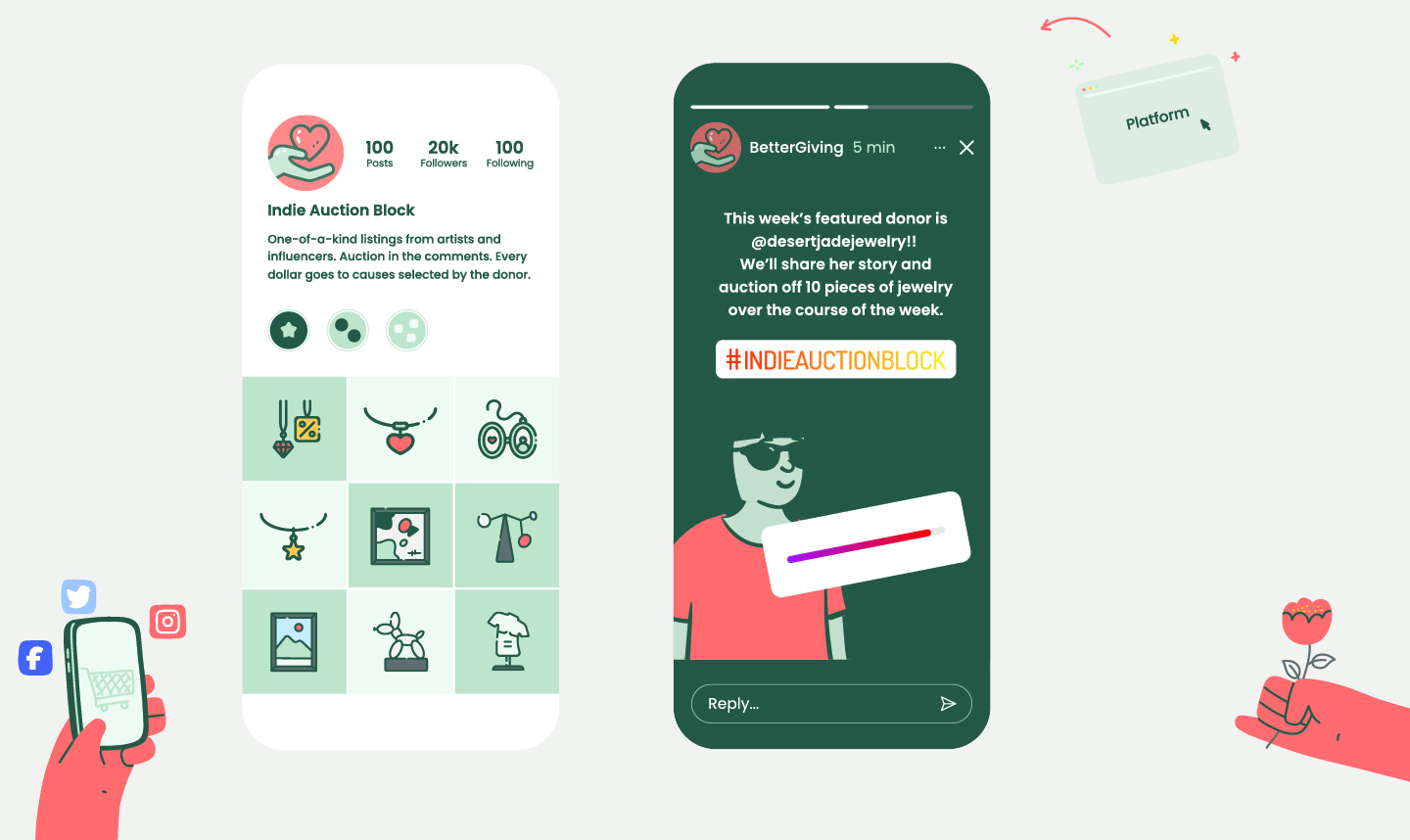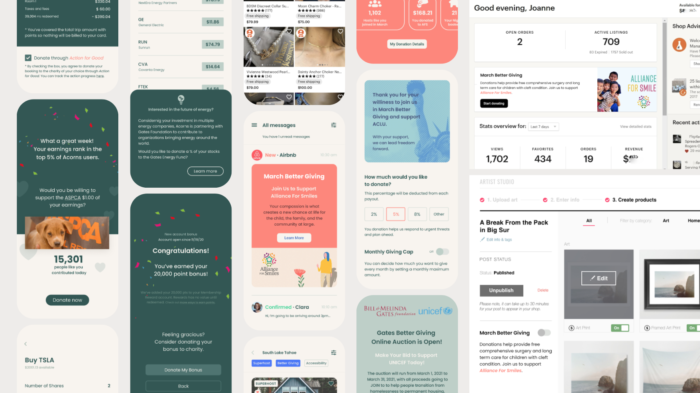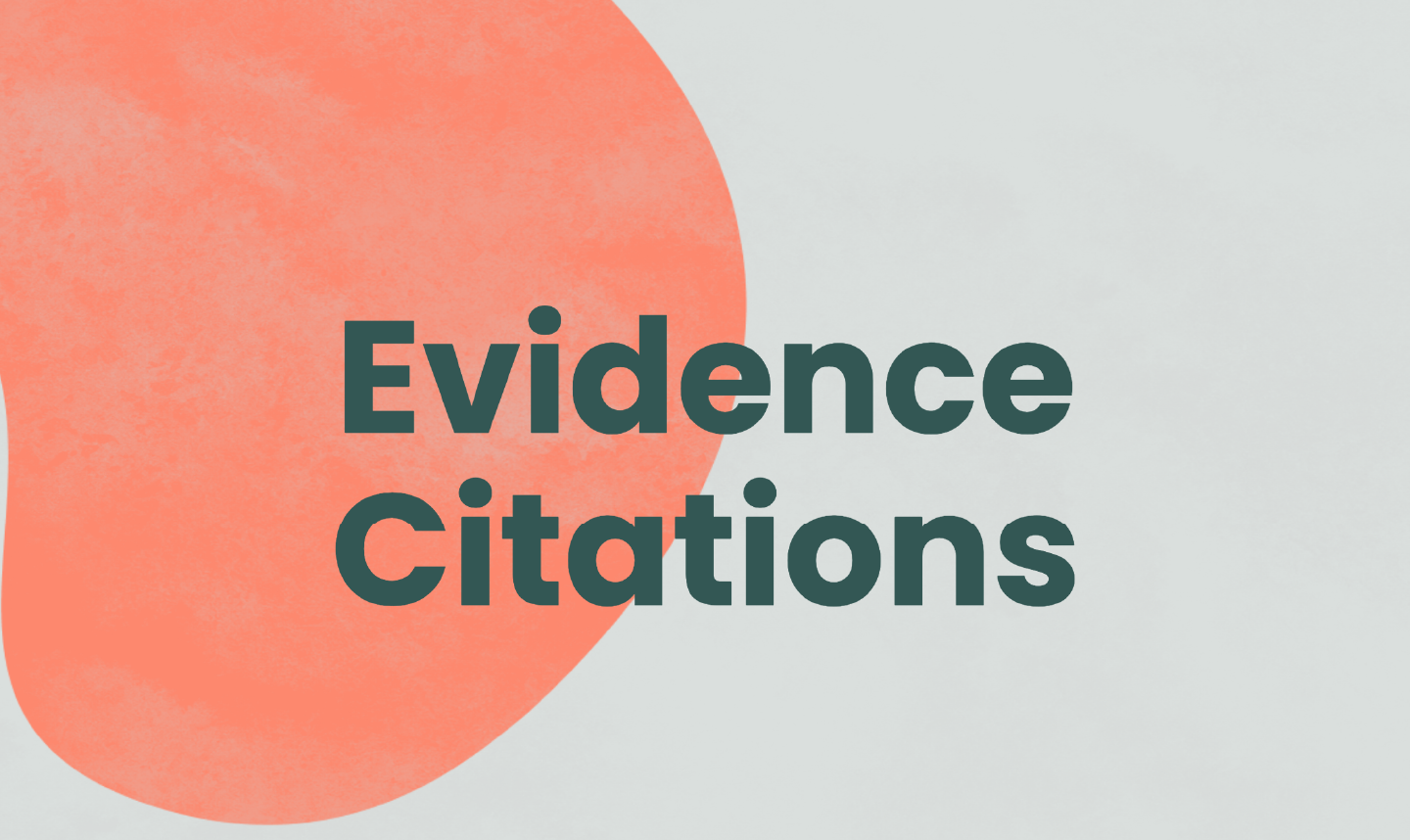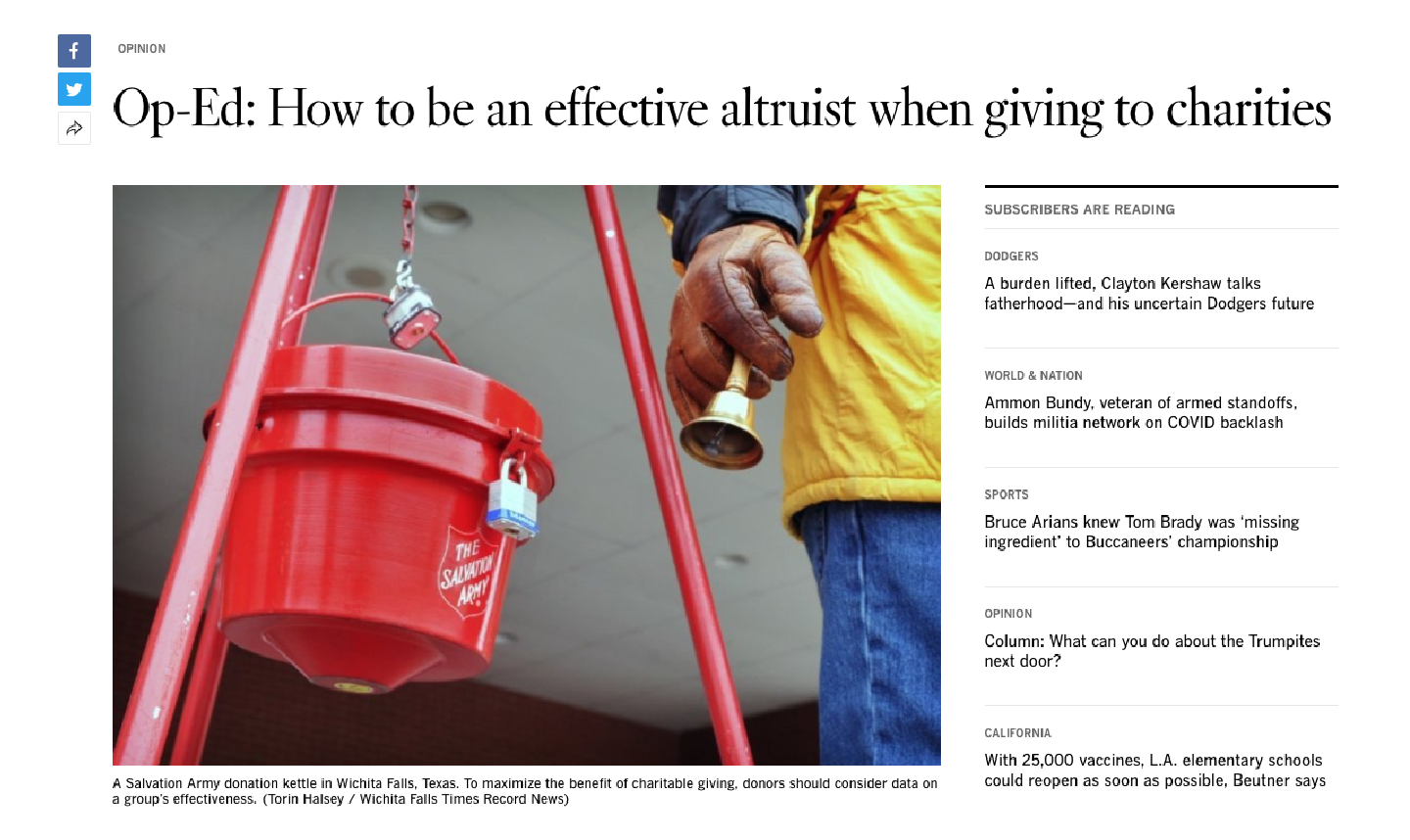The Charity Auction of the Future is Democratized and Distributed

April 2021
Behind the Refinement Sprint that explored the promising giving potential of multi-sided marketplaces like Etsy, Airbnb, and Society6.
Have you ever attended an old school charity auction? If you haven’t, imagine a big rented ballroom, fancy clothes, plenty of hors d’oeuvres, and an auction block featuring items and experiences that match the vibe.
Take any traditional auction listing, though, and there’s an online marketplace somewhere out there that appeals to a very different (see: younger) target audience. Fashion, artwork, and jewelry sell every day on platforms like Etsy, Instagram, and Society6. Vacation rentals and experiences are the currency of Airbnb, tickets trade hands on Stubhub, and even the proverbial “lunch with a local celebrity” can be found if you know where to look.
Our small team of IDEO designers, in collaboration with ideas42 behavioral economists, set out to explore what charitable giving might look outside the rented ballroom, focusing instead on online platforms like Etsy, Airbnb, and Society6. The answer, quite simply, got us pretty excited.
Where We Started
How might the in-kind donation model traditionally found at events like charity auctions be reimagined in light of everything we’ve learned about virtual services and experiences since March 2020?
Almost immediately, our research eyes focused on the types of multi-sided marketplaces mentioned in the paragraphs above. Platforms like Etsy, Airbnb, and Facebook Marketplace exist to match independent sellers with interested buyers. It’s no news to say these new marketplaces have revolutionized their industries and turned many people’s side hobby into a full-fledged business. What’s still early in development, however, is the emergence of these platforms as powerful avenues for new forms of charitable giving.
To get smart fast, we needed to talk to every player in the marketplace (seller, buyer, platform), as well as the nonprofits who could eventually benefit at the end of the line.
Design Research Approach
To “reimagine” something, as the initial “How might we…” statement suggests, doesn’t mean: “take an old idea like a charity auction and “put it on the internet.’” Design research works best when we start further upstream than that assumption.
Our team needed to understand how modern multi-sided marketplaces work — since that’s essentially what a charity auction is — and what they do to enable and encourage both of their customers (the buyers and the sellers). From the seller/renter perspective, we wanted to understand what matters most to them and how raising money for causes might fold into this side hustle that, often, plays an important role in their financial wellbeing.
In true IDEO fashion, we wanted to get at those answers by designing prototypes for people to react to.
Prototyping
A simple user interface design can ground conversations in the digital landscapes where they occur. Whether we’re proposing a new feature within a familiar interface, or introducing the concept of an entirely new product/service, the conversation is easier when folks are reacting to a stimulus rather than attempting to imagine it.
Our IDEO team created two buckets of prototypes:
- In-Platform Screens — Examples of what charitable giving integrations might look like within the app experience of existing websites such as Etsy, Airbnb, and Society6. We showed this experience from the supplier’s back-end dashboard perspective, as well as the shopper’s front-end browsing perspective.
- Off-Platform Auction — Sample screens of an auction experience that might occur outside of the platform people are familiar with. We wanted people to imagine a broader marketplace, featuring familiar offerings from multiple other marketplaces, all combined in one environment focused on sending 100% of the revenue to nonprofits.

Interview Strategy
During our interviews, we spent time with four categories of experts and users:
- Platform Side — We recruited experts who run smaller startup platforms, as well as folks from larger “unicorns” who focus on developing their company’s nonprofit activities. Testing prototypes with them helped us understand some “behind the scenes” realities around the technical feasibility and logistical viability of integrating donation features.
- Supply Side (“Side Hustle”) — The artists, property owners, and other entrepreneurial spirits who don’t rely entirely on the money they make from these platforms, but it still plays an important role in their overall bottom line.
- Supply Side (“Post Economic”) — The same types of people as the “Side Hustle” category above, but this group doesn’t necessarily rely on the money earned off the platform in an overly meaningful way, potentially freeing up more money to be donated to causes they care about.
- Consumer Side — Given the limited time for this sprint, we didn’t get overly exhaustive here, and tried to focus on younger, less affluent consumers who fall outside that traditional charity auction demographic.
One category we intentionally left out of this research was any platform like Uber, Lyft, or Doordash. In those cases, the “donate-ability” of the offer (rides, deliveries, etc.) felt less directly relatable to this research, and suppliers on those platforms also tend to be more reliant on that revenue than suppliers on other platforms.
Three Things We Learned
There’s Exciting Potential for this Category of Giver
Most of these marketplaces anchor into specific communities united by location, interest, or cultural ties. Buyers and sellers are more likely to have aligned interests, rooted in something a bit more meaningful than a transaction. (Consider: You likely don’t book a trip solely because it’s cheap, or buy art because it’s the right size for your wall.)
What that tends to mean is: a cause might really matter. The donors behind this idea tend to care (a lot) about the immediate community around where they rent their Airbnb, or the cultural moment that inspired their art.
The idea behind these platforms is to empower people. The same can, and should, be true for giving. The various creators and hosts have a strong point of view on where money should go, which is a very good thing!
Improvised Solutions Already Exist
It didn’t take much research to discover that people on these platforms already hack together their own means of using the sale of their goods/services to benefit causes that matter to them. Whether that’s an artist donating all the revenue from a particular print to wildfire relief, or an Etsy seller donating excess inventory to the local hockey team, the underlying premise of this idea is already alive.
These proverbial “bubblegum and duct tape” solutions are a key indicator of strong customer desirability. They are, literally, willing to make more work for themselves in order to do what we were testing.
Creators Are Customers & Big Platforms Exist to Serve Them
In a multi-sided marketplace, the term “customer” pertains to all participants. To Airbnb, both hosts and renters are considered customers. Any features or services provided by a platform owner must meet everyone’s needs.
In fact, the entire value of a platform is that they handle the tasks that distract others from their core business — Airbnb hosts, Society6 artists, Etsy creators can focus on the business of their business. The bigger the platform, the more complicated it might be to integrate a new feature. But so long as a feature serves a need of both customer types, without threatening their ability to sell, then there’s good reason for the platform to provide it.
So What’s Next?
The incredibly nuanced and complicated answer from our team is… Go make it happen!
The “improvised solutions” insight above is not present across most design work — it’s kind of rare that what we test is met with, “Oh yeah, I do this already.” This existence of these improvised solutions means it doesn’t take excess imagination to see the future we want to design. Instead of wholesale inventing, the challenge becomes simplifying and scaling.
What really raises this opportunity into the green light territory, though, is the type of charitable giving it stands to unlock. In 2020, Better Giving Studio ran the Reimagine Charitable Giving Challenge, which included language in the brief about a new (more inclusive, accessible) kind of giving that serves to benefit nonprofits that tend to get overlooked by large-scale corporate initiatives. To us, that means elevating the resources directed to smaller, local organizations.
Putting this power into the hands of the people on these platforms not only holds potential to reimagine the traditional charity auction, but also create a new vision for who has access to it and who benefits from it.
Take a look at the two concepts (The Indie Auction Block & More Mindful Marketplaces) created by our IDEO team on the BGS website as a great place to get started.
Other News
Dive into the Evidence


